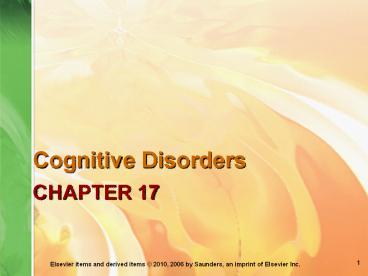Cognitive Disorders PowerPoint PPT Presentation
Title: Cognitive Disorders
1
CHAPTER 17
- Cognitive Disorders
2
Etiology
- Delirium
- An underlying systemic illness, including
infection, and endocrine disorder, trauma, and
drug/alcohol abuse - Dementia
- Classified as to the cause or area of brain
damage - Amnestic disorders
- Head trauma, hypoxia, encephalitis, thiamine
deficiency, and substance abuse
3
Differentiating Types of Cognitive Disorders
- Delirium
- Acute confusional state characterized by
disruptions in thinking, perception, memory - Dementia
- Chronic state characterized by declines in
multiple cognitive areas, including memory - Amnestic disorders
- Uncommon cognitive disorder characterized by
amnesia
4
Delirium Clinical Picture
- Disturbances in consciousness
- Change in cognition
- Develops over a short period of time
- Common in hospitalized patients, especially older
adults - Always secondary to another physiological
condition - Is a transient disorder
- If underlying condition corrected, complete
recovery should occur
5
Delirium Assessment
- Four cardinal features
- Acute onset and fluctuating course
- Inattention
- Disorganized thinking
- Disturbance of consciousness
6
Delirium Assessment
- Cognitive and perceptual disturbances
- Illusions
- Hallucinations
- Physical needs
- Mood and physical behaviors
- Attention span
- Reasoning
- Sleep and wake cycle
7
Delirium Nursing Diagnoses
- Risk for injury
- Acute confusion
- Deficient fluid volume
- Insomnia, Sleep deprivation
- Impaired verbal communication
- Fear
- Self-care deficit
- Disturbed thought process
8
DeliriumOutcomes Identification
- Patient will return to premorbid level of
functioning. - Patient will remain safe and free from injury
while in the hospital. - Patient will be oriented to time, place, and
person. - Patient will be free from falls and injury.
9
Delirium Implementation
- Prevent physical harm due to confusion,
aggression, or fluid and electrolyte imbalance. - Perform comprehensive nursing assessment to aid
in identifying cause. - Assist with proper health management to eradicate
underlying cause. - Use supportive measures to relieve distress.
10
Interventions for Delirium
- Introduce self and call client by name at each
contact - Maintain face-to-face contact
- Use short, concrete phrases
- Keep room well lit
- Keep environmental noise low
- Set limits on behavior
- 11 staffing as needed
11
Delirium Evaluation
- Patient will remain safe.
- Patient will be oriented to time, place, and
person by discharge. - Underlying cause will be treated and ameliorated.
12
Dementia
- Progressive deterioration of cognitive
functioning and global impairment of intellect - No change in consciousness
- Difficulty with memory, thinking, and
comprehension - Majority of dementias are irreversible
13
DementiaPrimary Versus Secondary
- Primary
- Irreversible
- Progressive
- Not secondary to any other disease
- Example Alzheimer's disease
- Secondary
- Result of some other pathological process
- Example AIDS-related dementia
14
Alzheimers Disease Etiology
- Biological factors
- Cerebral atrophy
- Neurofibrillary tangles
- Neuritic plaques
- Genetic
- Dementia of Alzheimers type
- Dementia from Huntingtons disease
- Dementia from Picks disease
15
Alzheimers Disease Etiology
- Environmental factor
- Dementia from CreutzfeldtJakob disease
16
Nursing Process
- Assessment
- Confabulation
- Perseveration
- Cardinal symptoms observed in AD
- Amnesia or memory impairment
- Aphasia
- Apraxia
- Agnosia
- Disturbances in executive functioning
17
Nursing Process
- Poor judgment
- Decline in previous abilities
18
Stages ofAlzheimer's Disease
- Stage 1 (Mild) forgetfulness
- Stage 2 (Moderate) confusion
- Stage 3 (Moderate to Severe) unable to identify
familiar objects or people - Stage 4 (Late) end-stage
19
Alzheimers Disease Nursing Diagnoses
- Risk for injury
- Impaired verbal communication
- Impaired environmental interpretation syndrome
- Impaired memory
- Confusion
- Caregiver role strain
20
Alzheimer's Disease Outcomes Identification
- Areas to target
- Injury
- Communication
- Agitation level
- Caregiver role strain
- Impaired environmental interpretation chronic
confusion - Self-care needs
21
Alzheimer's DiseasePlanning
- Geared towards persons immediate needs
- Identify level of functioning
- Assess caregivers needs
- Plan and identify appropriate community resources
22
Alzheimer's Disease Implementation
- Maintain optimal nutrition
- Counseling and communication techniques
- Health teaching and health promotion
- Referral to community supports
- Structure the environment to support cognitive
functions - Pharmacological interventions
23
Pharmacological Interventionsfor Alzheimers
Disease
- Tacrine (Cognex)
- Donepezil (Aricept)
- Rivastigmine (Exelon)
- Galantamine (Razadyne)
- Memantine (Namenda)
- Slows the rate of cognitive decline
- Potent acetylcholinesterase inhibitors
24
Common Medications for Cognitive Disorders
- Dementia with Lewy Bodies
- Escitalopram (Lexapro)
- Reduce symptoms of depression when present
- Picks Disease
- Valproic Acid (Depakote)
- Reduce problematic mood swings and agitated
behavior - Vascular Dementia with psychosis
- Quetiapine (Seroquel)
- Reduce or eliminate delusions and hallucination
25
Amnestic Disorder
- Characterized by short-and long-term memory
deficits - Inability to recall previously learned
information or past events - Inability to learn new materials
- Cofabulation, apathy, bland affect
- Amnestic disorder NOS not enough supporting
evidence to link a cause to the amnesia (medical
or substance)
26
Depression
- Depression can be masked by symptoms suggestive
of dementia - The term pseudodementia is used to describe the
reversible cognitive impairments seen in
depression - Pseudodementia is characterized by an abrupt
onset, rapid clinical course, and client
complaints about cognitive failures
27
Caregiver Difficulties
- Wandering behaviors
- Sundowning disorientation
- Activities of Daily Living
- Medication management
- Burnout and fatigue
28
Caregiver Resources
- Family meetings
- Alzheimers Disease and Related Disorders
Association (ADRDA) - Caregiver support groups
- Identify community resources
- ID bracelet for the client

